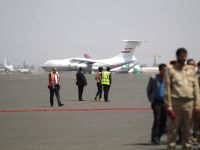Osama bin Laden is dead and Americans are rightfully taking a victory lap. But the greatest threat to the nation’s safety and security over the past five years has not been from bin Laden’s al-Qaeda, dug into Afghanistan and Pakistan. It’s been from a Yemen-based offshoot called al-Qaeda in the Arabian Peninsula (AQAP).
Remember Afghanistan on September 10, 2001? Today’s Yemen is worse. AQAP is holed up in the roughest part of a failing state with a collapsing central government, a non-existent economy and an anti-American population, a huge number of whom are wasted every day on qat, a narcotic leaf that is the crop of choice in the country. Clean water is running out, the birthrate is among the highest in the world and more than half the population is illiterate. It’s enough to make Afghanistan look inviting.
AQAP came out of the remnants of al-Qaeda in Iraq. Its leaders, mostly Saudis and Yemenis, went to Saudi Arabia, but were driven out when Riyadh finally got serious about fighting its own chickens-home-to-roost terrorism. Since then, the group has launched several deadly attacks.
In 2008, AQAP militants attacked the US Embassy in Sana’a, killing 11 people. In 2009, a senior AQAP operative offered to surrender to Saudi authorities, requesting a meeting with Saudi counterterrorism czar Prince Muhammad bin Nayif Al Saud. Muhammad agreed to the meeting and flew the terrorist to Saudi Arabia on his private jet, only to have the man detonate homemade plastic explosives hidden in his underwear. Muhammad was seriously injured. A year later, Nigerian student Omar Farouk Abdulmutallab sewed a similar bomb into his underwear and tried to blow up a Northwest Airlines flight as it arrived in Detroit on Christmas Day. Late last year, AQAP tried to send bombs concealed in emptied toner cartridges to addresses in the U.S. via UPS and Federal Express, successfully getting them into aircraft cargo holds.
To make matters worse, as many as 36 American ex-convicts who converted to Islam in U.S. prisons went to Yemen in 2009, ostensibly to study Arabic. The FBI, however, believes that they went to undergo training in AQAP camps in eastern Yemen. Scary? You bet. And there’s no way to stop them. They have valid U.S. passports, they’ve done their time and it’s up to U.S. law enforcement agencies to prove that they were in Yemen for terrorist training.
A year ago, the Senate Foreign Relations Committee issued a report warning of terrorism in Yemen, an emerging failed state in every way. But in 2010 there wasn’t a danger of the country’s entire political system falling apart. Today that’s the reality. Yemen’s President Ali Abdallah Saleh leads little more than the city of Sana’a. Most of the outlying areas are either engaged in rebellions, are ungoverned or are under AQAP’s control. And Saleh spends most of his time shooting his own people who are engaged in peaceful demonstrations.
Couple that with Yemen’s economic, demographic and societal realities and you have a disaster in the making. Yemen’s oil -- the source of over 75 percent of its income -- will run out by 2017, and the country has no apparent way to transition to a post-oil economy. Water shortages are already acute throughout the country, and Sana’a may be the first capital city in the world to run out of water. The mix of a high birthrate, little education, and extreme unemployment is toxic.
Many counterterrorism experts believe that Yemen is beyond the point of no return. Drone attacks aren’t going to destroy AQAP. A strong central government, democracy and economic opportunity might. But if the country continues to circle the drain, robust intelligence collection and boots on the ground may be required to crack AQAP. It’s a task in which the whole world has a stake -- after all, bin Laden’s al-Qaeda had Europe, Asia and Africa in its crosshairs for a decade, not just America. And if the United States does go it alone, it could find itself mired in another hostile environment for a generation.








